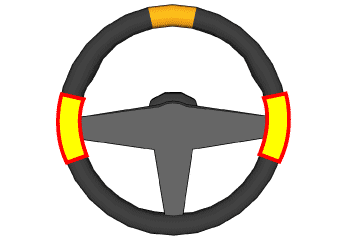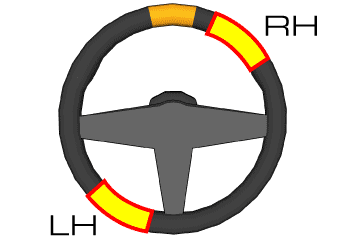Steering
Good steering technique is crucial for smooth driving, as it prevents any sudden lateral weight transfers which allows the corner to be taken at a higher speed.
Driving position
When getting ready for the track you should adjust your seat to a much more upright position than you may use when driving on the road. You should be able to rest your wrists comfortably on the top of the steering wheel while keeping a slight bend in your arms. This may mean moving closer to the wheel than you normally would which can feel strange at first, but will give you maximum control.
Hand position
When driving on a stretch of straight or gently curving tarmac, the default hand position is quarter to three (Figure 1). When taking tighter corners it will be necessary to adjust hand position accordingly. Grip the wheel with a firm but relaxed grip, but not so hard that your knuckles turn white! Try to maintain this position unless it isn’t possible to take the corner in this way, as this gives you the advantage of instantly knowing exactly where the straight ahead position is, and the ability to steer rapidly yet smoothly.
For a tight right hand hairpin, a suggested hand position is shown in Figure 2. This will allow the lock to be applied and taken off without either taking hands off the wheel or adjusting the hand position until after the corner has completed. If your car has a large number of turns from lock to lock, you may need to start with your right hand further anti-clockwise.
Steering movements
When steering round a corner, the ideal steering movement is progressive, smooth and controlled. Applying and taking off steering lock should be done in a fluid movement, without taking either hand off the wheel where possible. ‘Pushing and pulling’ the wheel may be fine for general road driving, but this does not allow the smooth motions needed when driving near the limits of grip. Try not to let the steering wheel slide through your fingers when letting off steering lock, and then adjust your hand position accordingly for the next corner or straight. In some situations when you need to take the lock off very quickly – you may find it easier to let the wheel slide through your fingers slightly, but this should be avoided where possible. An example could be when letting off the steering lock after a dramatic oversteer correction.
Steering through a corner
When taking a corner, aim for the apex and turn in a smooth controlled arc – don’t use aggressive steering unless you’re deliberately trying to unsettle the car (e.g. for a handbrake turn). Once you’ve clipped the apex, unwind the steering lock progressively as you increase the throttle. If you find you have to tighten up mid-corner you’ve hit the apex too early, and if you find you don’t need to use the entire width of the track on the exit you’ve probably left your cornering too late.



Should I remove my hands off the steering wheel to place them in the correct position when I’m preparing for a turn?